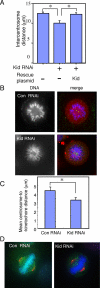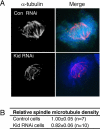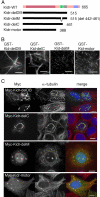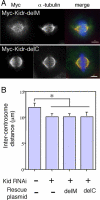The chromokinesin Kid is required for maintenance of proper metaphase spindle size
- PMID: 16176979
- PMCID: PMC1266440
- DOI: 10.1091/mbc.e05-03-0244
The chromokinesin Kid is required for maintenance of proper metaphase spindle size
Abstract
The human chromokinesin Kid/kinesin-10, a plus end-directed microtubule (MT)-based motor with both microtubule- and DNA-binding domains, is required for proper chromosome alignment at the metaphase plate. Here, we performed RNA interference experiments to deplete endogenous Kid from HeLa cells and confirmed defects in metaphase chromosome arm alignment in Kid-depleted cells. In addition, we noted a shortening of the spindle length, resulting in a pole-to-pole distance only 80% of wild type. The spindle microtubule-bundles with which Kid normally colocalize became less robust. Rescue of the two Kid deficiency phenotypes-imprecise chromosome alignment at metaphase and shortened spindles- exhibited distinct requirements. Mutants lacking either the DNA-binding domain or the MT motor ATPase failed to rescue the former defect, whereas rescue of the shortened spindle phenotype required neither activity. Kid also exhibits microtubule bundling activity in vitro, and rescue of the shortened spindle phenotype and the bundling activity displayed similar domain requirements, except that rescue required a coiled-coil domain not needed for bundling. These results suggest that distinct from its role in chromosome movement, Kid contributes to spindle morphogenesis by mediating spindle microtubules stabilization.
Figures







References
-
- Antonio, C., Ferby, I., Wilhelm, H., Jones, M., Karsenti, E., Nebreda, A. R., and Vernos, I. (2000). Xkid, a chromokinesin required for chromosome alignment on the metaphase plate. Cell 102, 425-435. - PubMed
-
- Cooke, C. A., Schaar, B., Yen, T. J., and Earnshaw, W. C. (1997). Localization of CENP-E in the fibrous corona and outer plate of mammalian kinetochores from prometaphase through anaphase. Chromosoma 106, 446-455. - PubMed
-
- Elbashir, S. M., Harborth, J., Weber, K., and Tuschl, T. (2002). Analysis of gene function in somatic mammalian cells using small interfering RNAs. Methods 26, 199-213. - PubMed
-
- Funabiki, H., and Murray, A. W. (2000). The Xenopus chromokinesin Xkid is essential for metaphase chromosome alignment and must be degraded to allow anaphase chromosome movement. Cell 102, 411-424. - PubMed
Publication types
MeSH terms
Substances
LinkOut - more resources
Full Text Sources
Other Literature Sources

